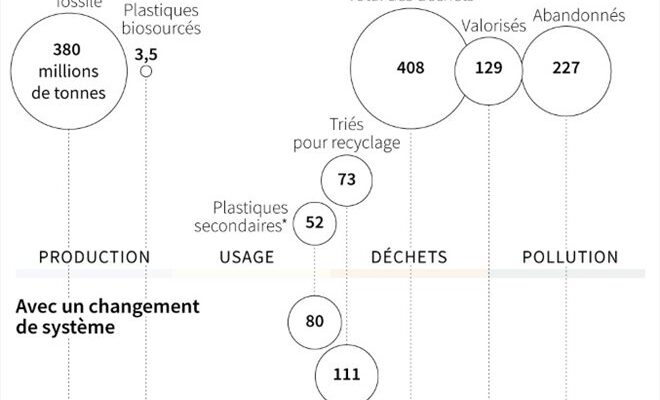A 5-meter high installation made from plastic bottles by Canadian artist and activist Benjamin Von Wong, in Paris, May 27, 2023 (AFP/BERTRAND GUAY)
Ministers or representatives from around 60 countries discussed solutions to the global plastic crisis at Unesco on Saturday, a summit organized by France to give impetus to the delicate negotiations on a future global treaty which resume on Monday in Paris.
“We discussed the production of plastic, their composition, the fight against microplastics, also the question of better collection and recycling, and in particular support for developing countries which sometimes encounter more difficulties in collecting”, said summary at the end of the day, Secretary of State for Ecology Bérangère Couillard during a press briefing.
“We must be careful that the question of recycling does not replace the debate on the reduction of the production of plastics”, had however warned the Minister of Ecological Transition Christophe Béchu, before the debates.
This issue is shaping up to be a key point in the negotiations as annual production has more than doubled in 20 years to reach 460 million tonnes (Mt). It could still triple by 2060 if nothing is done.
However, two-thirds of this global production has a short lifespan and becomes waste to be managed after just one or a few uses. 22% are abandoned (wild dumps, open-air incineration or discharge into nature) and less than 10% are recycled.
“If we increase our recycling rates, but at the same time we increase our production, we will have gone backwards in solving the problem. So, firstly we reduce, secondly we increase the share of recycling”, added the minister.
This perspective is supported by the Coalition for High Ambition, led by Rwanda and Norway and made up of 56 countries, including the European Union, Canada and Chile. Since Friday, Japan, Gabon and the Republic of Mauritius have joined this bloc. And Argentina expressed interest on Saturday, according to Ms. Couillard.

Recovering plastic bottles from a landfill in Banda Aceh on May 31, 2022 (AFP/Archives/CHAIDEER MAHYUDDIN)
Reducing production in the first place is also hammered by NGOs and scientists. But other nations, on the side of Asia (China and India in particular) or the United States, are more reluctant, insisting on recycling and better waste management.
“Each country must be clear on the objective” of reducing environmental discharges to zero by 2040, US Minister Jose W. Fernandez, who leads the delegation to Paris of state negotiators, told AFP. -uniens.
But “we should leave it to each country to chart its course” to fulfill this commitment, already made by the G7 countries in April. This involves concluding a “flexible” rather than “prescribing” treaty, “without demonizing” plastic, according to Mr. Fernandez.
“The strongest evidence shows that reducing production will be key to solving the problem,” said Richard Thompson, a member of the Coalition of Scientists for a Successful Plastic Process.
The minimal share of recycling is also explained because “few products have been designed with a view to a circular economy”, he explained, recalling the need to “rethink the design of materials”, one of the leitmotivs of the company. UN-Environment.
– Draft text? –
In 2022 in Nairobi, 175 countries reached an agreement in principle to end plastic pollution with the ambition to develop a legally binding treaty by the end of 2024 under the aegis of the United Nations Environment Programme. environment (UNEP).
After technical discussions at the end of 2022 in Uruguay, Paris is hosting the second session of negotiations, out of the five planned, from Monday to Friday. It should make it possible to draw the main orientations, or even a first draft of the text.
The stakes are high because plastic, derived from petrochemicals, is everywhere: packaging, clothing fibers, construction equipment, medical tools…

The two scenarios for the future of plastic (AFP/Sabrina BLANCHARD, Julia Han JANICKI)
Waste of all sizes ends up at the bottom of the oceans, in sea ice, in the stomachs of birds and even on top of mountains. Microplastics have been detected in blood, breast milk or placenta.
Plastic also poses a problem for its role in global warming: it represented 1.8 billion tonnes of greenhouse gases in 2019, 3.4% of global emissions, a figure that could more than double by 2060 according to the OECD.
© 2023 AFP
Did you like this article ? Share it with your friends with the buttons below.




